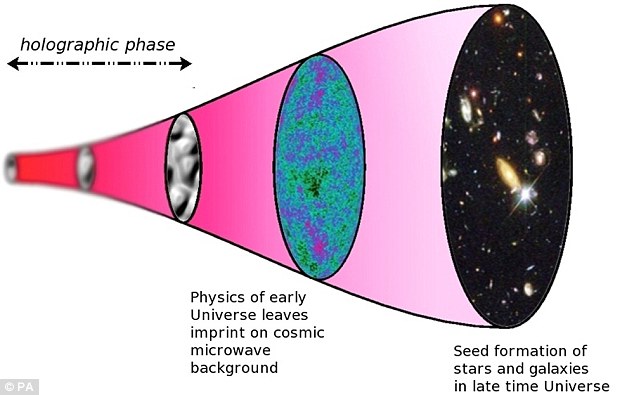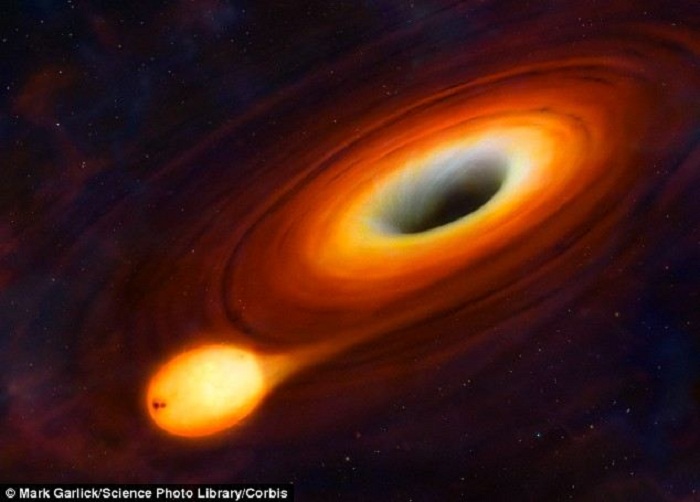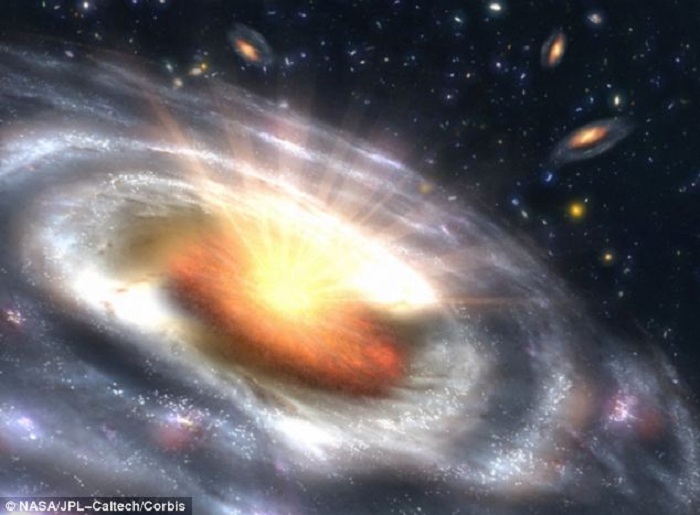They say they have found `substantial evidence` to support the idea of a holographic universe that will transform our knowledge of the entire universe.
The researchers from the University of Southampton, working with colleagues in Canada and Italy, claim there is as much evidence for this theory as for traditional explanations for these irregularities.
A holographic universe, an idea first suggested in the 1990s, is one where all the information, which makes up our 3D `reality`is contained in a 2D surface on its boundaries.
Until now the bizarre theory had rarely been tested, but recent mathematical models suggest that the mind-boggling principle could be true.
Professor Kostas Skenderis, of mathematical sciences at the University of Southampton, said: `Imagine that everything you see, feel and hear in three dimensions (and your perception of time) in fact emanates from a flat two-dimensional field.
`The idea is similar to that of ordinary holograms where a three-dimensional image is encoded in a two-dimensional surface, such as in the hologram on a credit card.
`However, this time, the entire universe is encoded.`
He said the theory could be compared to watching a 3D film in a cinema.
Although this is not a hologram, he explained that we see the pictures as having height, width and, crucially, depth when in fact it all originates from a flat 2D screen.
The difference, in our 3D universe, is that we can touch objects and the `projection` is `real` from our perspective, he said.
To test their theory, the team looked at features or irregularities in the white noise` left over from the moment just after the universe was created.
This is also known as cosmic microwave background, or CMB.
Their equation showed that if the universe was a hologram, the structure of these irregularities could be explained.
`I do think we live in a hologram, and I think if we move forward in time, say 50 years from now, then physics will look very different in the same way that physics from the 20th century now looks different,` Professor Skenderis told MailOnline.

Pictured is a timeline of the holographic universe. Time runs from left to right. The far left denotes the holographic phase. At the end of this phase (shown by the black fluctuating ellipse) the Universe enters a geometric phase, which can now be described by Einstein`s equations. The cosmic microwave background was emitted about 375,000 years later
Professor Skenderis added: `Holography is a huge leap forward in the way we think about the structure and creation of the universe.
`Einstein`s theory of general relativity explains almost everything large scale in the universe very well, but starts to unravel when examining its origins and mechanisms at quantum level.
`Scientists have been working for decades to combine Einstein`s theory of gravity and quantum theory.
`Some believe the concept of a holographic universe has the potential to reconcile the two. I hope our research takes us another step towards this.`
The researchers, from the University of Southampton, University of Waterloo, Perimeter Institute, INFN, Lecce and the University of Salento, have published their findings in the journal Physical Review Letters.

The universe could be a `vast and complex hologram` and our perception of life in 3D may only be an illusion. That`s according to a group of theoretical physicists, who have been investigating irregularities the `afterglow` of the Big Bang
/Daily Mail/
















































